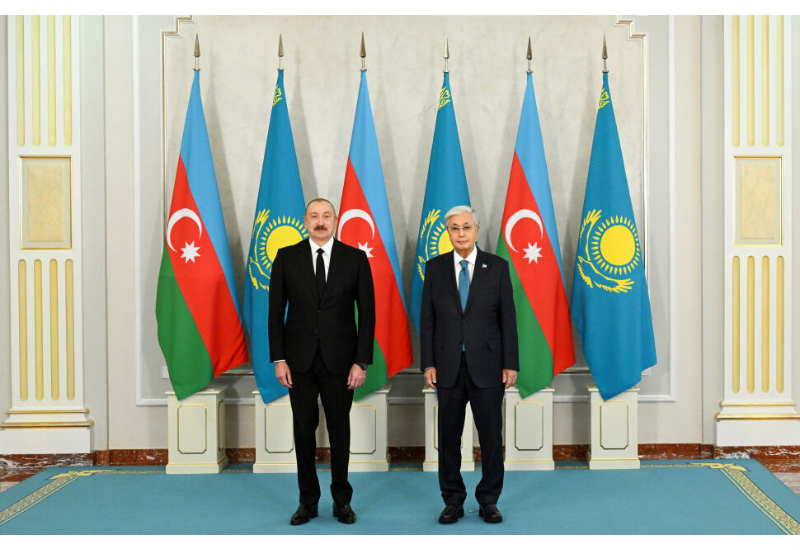|
|
TODAY.AZ / Society
Azerbaijani historical monuments vandalized
10 March 2006 [10:05] - TODAY.AZ

Armenia's false land claims against Azerbaijan don't ground on any historical source, so official Yerevan's stance is like the behavior of naughty child. Works written on the basis of Armenian scholars "Historical evidences" are a part of Armenian state-level aggression policy.
Pro-Armenian international organizations pursue biased policy on the basis of these "historical evidences". On the basis of scientific, epigraphic, medieval sources, Azerbaijani scholars prove that Armenian political element has never existed in the Southern Caucasus historically.
Analysis of the documents brings to work out new historical conception of the Southern Caucasus and proves that the history of Azerbaijan was distorted by Armenian historians. Armenian's first state was created in the Western Azerbaijani lands by the Soviet Russia and the Entente in 1920. Azerbaijanis were deported from these lands during the Soviet Union period, material-cultural monuments were razed and the place names were substituted for Armenian words.
Azerbaijanis underwent massive terror and began to flee these lands after 1988 and after that all Azerbaijani material-cultural monuments in there were destroyed by Armenians. That's chronicle about changed name places, razed monuments in these territories. The first portion of information is about monuments, place names vandalized by Armenians in Zengezur.
Zengezur. Urud graveyard
Ram-form gravestones dated to XV-XVI centuries were found in Urud graveyard (Armenians changed this village's name into Oront) in 1961. Epitaphs and pictures of the gods of Turkish tribes prove that Alban tribes converted to Islam and became Turk- Azerbaijanis. These findings wiped out “the conception that Alban tribes converted to Georgian and Armenian after invasion of Caliphate. These historical monuments proved that Azerbaijanis are one of the oldest and deep-rooted people in the Caucasus and proved that Armenians' opinion "Azerbaijanis is a coming people to the Caucasus" is groundless. Armenian scholars say "the calligraphers were uneducated and made many mistakes in the epitaphs". So, Armenians distorted the writings and added letters to the epitaphs. They read "avlade-avgvan" (descendants of Albans) like "avlagum vagudlu", they tried to "prove" that Azerbaijanis never lived in Zengezur but they failed. So, Armenians razed the medieval Urud graveyard in Zengezur.
Zengezur. Salim pass caravanserai
Salim pass caravanserai was built during Elkhani Abu Said's period in Zengezur- on the Silk Way--the great trade way from Anatolia to China. Armenians published this caravanserai as "Armenian national architecture monument" (Arutunyan V.M, Yerevan-1984 and (KGPA, t. III #991, page 62). The stone inscription on Yahya Ibn Mahammad tomb in Mammadbayli village, Zengezur is identical to the stone inscription on the Salim pass caravanserai.
The architect name of Ali Macdaddin, who made all monuments on the Silk Way in XVI, was written on these epitaphs. One writing in Armenian language was put into the monument. The context of this writing doesn't agree with the stone inscription on the monument. Armenian writing says that this monument was made by Caesar from Orbelyan family in 1332. Lazar University professor Kuchuk-Ioannasov claims that Azerbaijanis called the caravanserai Salim later and put the Arabic stone inscription above the door. But the Arabic writing was put during the construction.
The name of the monument was also printed as Salim Caravanserai in Armenian booklet. If this monument is national and cultural monument of Armenians, why do they call this monument as "tatars" do?
Zengezur. Jafarabad Tomb
The other Azerbaijani monument Armenians want to "privatize" is the noblest monument in Jafarabad village (Argavang now) 8 km far from Yerevan. The monument was built during the period of Saad emirs in Gara-Goyunlu state (1413). Armenians invited Turkmenistan scholars to the excavation works and concluded that Gara-Goyunlu state was an Iranian state but the state was headed by Turkmen (they mean the modern Turkmen). They try to present the tomb as Armenian cultural monument. This absurd scientific conclusion can be yielded by an ill-mind only. Identifying Gara-Goyunlu emirs with Turkmen is unscientific and incorrect. Because Gara-Goyunlu elements consisted of Oghuz Turks and Turkmen tribes lived in Anatolia in XIII. Their central residential zone was Archish in the north of Lake Van. Besides, this monument is identical to Momune Khatun and Yusif bin Kebir tombs in Nakhchivan according to their architecting-constructive form and can be regarded as the continuation of Ajami Abu Bakr architect school.
There were some more tombs and Azerbaijani graveyards in the said territory but all of them were destroyed. (KGPA, t.III, # 1027, Page 66-67).
Zengezur. Mosque
There were 382 Shiite mosques and 9 Sunnite mosques in Yerevan and Zengezur in 1915. There mosques increased in number as shown below: 201 mosques in 1904, 342 in 1911 and 382 in 1915. This increase dynamics shows that Muslims increased in this zone speedily and Muslim figures had great influence. Mosques were located in the villages of Zengezur such as Sheki, Vagudi, Merdhuz, Garrak, Saldash, Karkyal, Agbas, Agbag, Hajiemi, Balligaya, Karkas, Charali, Khardjmagli, Dastakend, Galajig, Jijimli 1, Jijimli 2, Garochali, Seydler, Mollalar, Teze Kilse, Nerjan, Zor, Afandiler, Pasan, Khurtekes, Hajigambar, Garabaghlar, Demirchiler, Dondarli, Kurdalug, Ulajli, Sarajli, Derzili, Okhchi, Kaglar. Yerevan province had 36 mosques in Echmiedzin region, 47 in Surmeli, 63 in Sherur-Dereleyez, 14 in Novobayazed and 54 in Irevan. These mosques registered birth, death and marriage and divorce. Molla was appointed in the mosques by the governors. Up to early XX century, there were mosques such as Gadim Sheher, Jame, Haji Novruzalibay, Haji Imamverdibay, Mirza Safibay, Haji Jafarbay in Yerevan. There were a madrese in Jame mosque in Yerevan. Most of these monuments were vandalized by Armenians or their names were changed.
Zengezur. Place Names
The other direction in Armenian vandalism policy was to change place names which show that these lands' belong to Turks. All place names were substituted for Armenian names in Armenia. E.g. Urud-Oront, Jafarabad-Argavang, Zeyve-Metsamor etc. they changed the place names to wipe out the trace of Azerbaijanis in these lands. There was Mir Davud tomb, who was the grandson of 8th imam Rza, in Pir Davud village, Zengezur and Seyid Ehmed tomb, who was the son of 7th imam Museyi-Kazim, in Gara Vali village. The both monuments were destroyed by Armenians.
/APA/
URL: http://www.today.az/news/society/24001.html
 Print version
Print version
Connect with us. Get latest news and updates.
See Also
- 23 October 2025 [15:16]
Border troops seize large quantity of narcotics at Iran border - 22 October 2025 [14:34]
Azerbaijan awards Yagub Eyyubov "Istiglal" Order - decree - 22 October 2025 [11:03]
AZAL flight carries Azerbaijani experts to Yerevan for civil society meeting - 22 October 2025 [10:51]
Azerbaijani Prime Minister Ali Asadov attends Tbilisi Silk Road Forum - 21 October 2025 [11:02]
Azerbaijan’s Education Minister meets Azerbaijani students in USA - 21 October 2025 [10:00]
Azerbaijan, Kazakhstan discuss digital and innovation cooperation in Astana - 20 October 2025 [15:41]
Azerbaijan's military official honors special forces on fifth anniversary of victory - 20 October 2025 [14:03]
Landmine explosion injures ANAMA employee in Khojavend - 20 October 2025 [12:42]
High-speed internet, digital services reach thousands in Azerbaijan’s liberated territories - 20 October 2025 [12:23]
Humanitarian demining efforts advance with significant land cleared for reconstruction
Most Popular
 Alone in field is not warrior: time has come for military component of OTG
Alone in field is not warrior: time has come for military component of OTG
 Azerbaijan and Kazakhstan are taking region's geopolitics into their own hands
Azerbaijan and Kazakhstan are taking region's geopolitics into their own hands
 Azerbaijan’s green energy shift redraws map from Central Asia to Europe
Azerbaijan’s green energy shift redraws map from Central Asia to Europe
 Azerbaijan to begin satellite manufacturing, launches new space industry milestone
Azerbaijan to begin satellite manufacturing, launches new space industry milestone
 Paraguay seeks greater influence in divided MERCOSUR as trade with the EU gains traction
Paraguay seeks greater influence in divided MERCOSUR as trade with the EU gains traction
 President Ilham Aliyev, President Kassym-Jomart Tokayev make press statements
President Ilham Aliyev, President Kassym-Jomart Tokayev make press statements
 Azerbaijan lifts all restrictions on transit of goods to Armenia - President
Azerbaijan lifts all restrictions on transit of goods to Armenia - President
